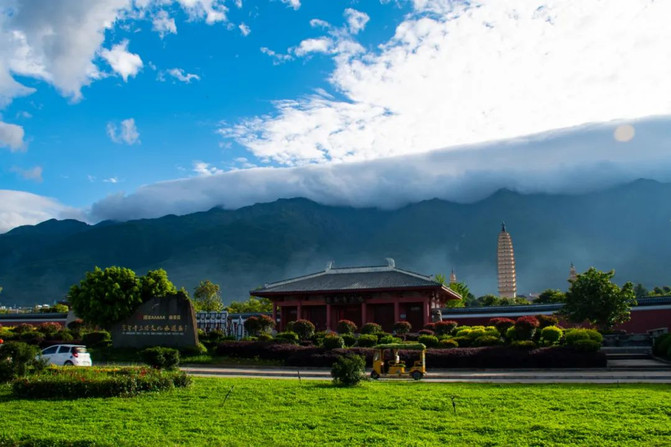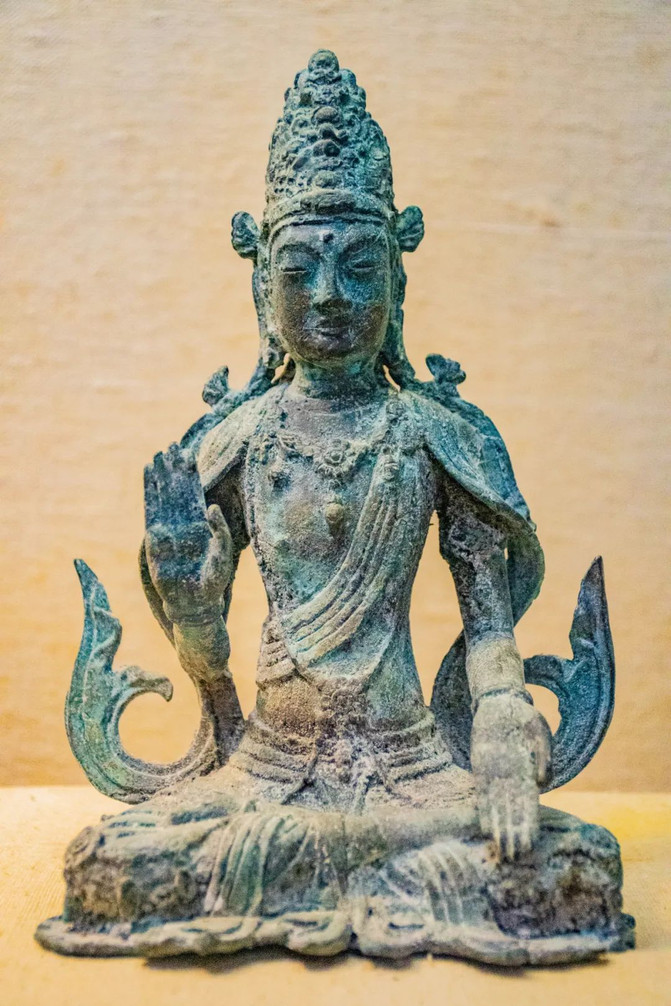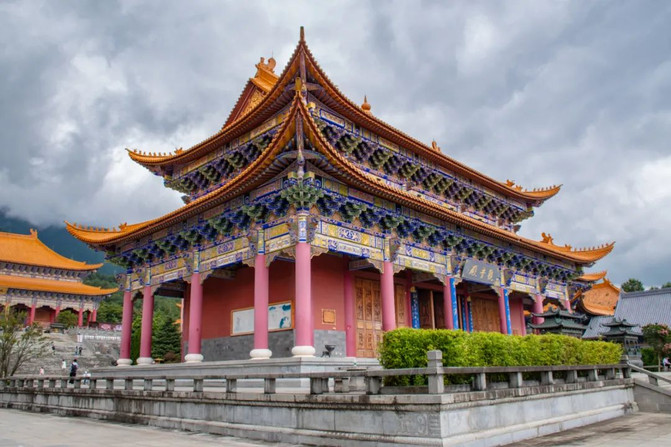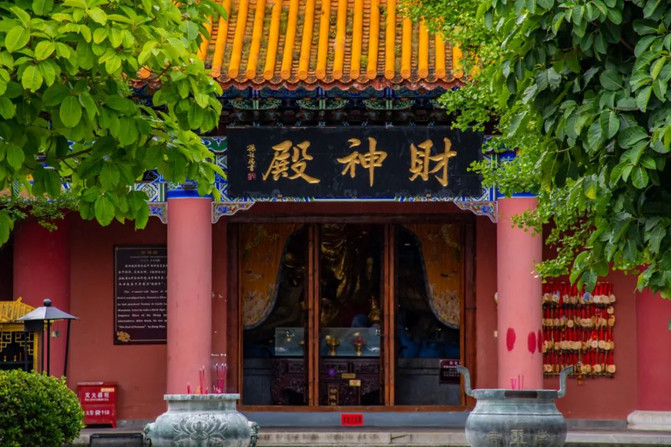Dali culture is located in the three pagodas of Chongsheng Temple? This is true. Culture, architecture and cultural relics tell you why
Many people know that Dali is called a "famous country in literature", but no one has ever delved into why Dali is called a "famous country in literature"?
Taking this opportunity, we walked into the Three Towers Cultural Tourism Area of Chongsheng Temple, where Dali culture is deepest, and learned about Dali culture from ancient times to the present.
If the cultural relics from the three pagodas of Chongsheng Temple could speak, what unknown secrets would it tell us?

Chongsheng Three Pagoda Cultural Tourism Zone is a symbol of Dali's "famous literature state" and a symbol of ancient history and culture in Yunnan. The three towers in the tourist zone are one of the oldest and most majestic buildings in southern China and are the first batch of national key cultural relics protection units announced in China.
The most historical ones in the Chongsheng Temple Three Pagoda Cultural Tourism Zone are the three towers, three towers. Among them, the large tower, Chihiro Tower, was built earliest. It was built during the Tang Nanzhao Quanfengyou period. They are both brick towers of the Tang Dynasty, so the shape is similar to the Big Wild Goose Pagoda in Xi'an.

Throughout history, the culture of the three pagodas of Chongsheng Temple started from Chongsheng Temple and gradually developed and developed.
In the history of Yunnan, Dali is a place that cannot be ignored. It was the capital of the Nanzhao Kingdom and Dali Kingdom, the ethnic regimes of ancient Yunnan.
Looking back at the history of Nanzhao, the three pagodas of Chongsheng Temple accounted for a small proportion in the early days of Nanzhao Kingdom, because the culture of the three pagodas of Chongsheng Temple was in its infancy at that time.

When the three pagodas were first built, people's admiration for Buddhist culture gradually deepened. As time went by, the three pagodas of Chongsheng Temple continued to grow.
The regime continues to fall and rise, but the only thing that is unhindered is the development of the three pagodas of Chongsheng Temple.
By the Dali State of the Song Dynasty, the three pagodas of Chongsheng Temple were already at their peak, and both scale and fame could not be ignored. The three pagodas of Chongsheng Temple have also become places closely related to Dali culture.

From ordinary people to the ruler of Dali Kingdom, the Duan family is inseparable from the three pagodas of Chongsheng Temple. You can understand the details for yourself. The three pagodas of Chongsheng Temple at this time concentrated the cultural essence of the two eras and became shining.
After more than a hundred years, some of the buildings in the three towers of Chongsheng Temple were destroyed in the war and continued to recover, gradually becoming what they are today. The culture of the three towers of Chongsheng Temple has long been not limited to the three towers of Chongsheng Temple, but has spread in the Dali area with continuous development.

It can be seen from ancient culture that a large number of precious cultural relics were basically buried in or under the pagodas. The three pagodas of Chongsheng Temple continued to develop, and the three pagodas still stand still after thousands of years of wind and rain erosion. Therefore, these places may also contain cultural relics, and this conjecture was also confirmed when a large number of precious cultural relics were unearthed at the top and bottom of the three pagodas.

A total of more than 680 precious cultural relics have been excavated within the three pagodas of Chongsheng Temple, with the largest number of cultural relics unearthed at the top and bottom of the three pagodas, and most of these cultural relics are hidden in the Three Pagoda Cultural Relics Exhibition Hall.
Walking into the exhibition hall, you will find that most representative cultural relics are presented here.
The cultural relics in the exhibition hall mainly include Buddha statues, Buddhist scriptures, and tower molds. The types of Buddha statues are quite wide, and the statue materials are also very diverse, such as copper cast, jade cast, iron cast, etc.






Among them, the Buddha statues are also very rich in shapes, sitting cross-legged, standing, etc., with beautiful faces, lifelike expressions, unique and exquisite shapes, which are impressive.



Among them, the Dapeng Golden-Winged Bird and the Acuoye Guanyin Statue are the most representative. The Dapeng Golden-Winged Bird was placed on the top of Chihiro Tower before excavation, and the Acuoye Guanyin Statue represents the uniqueness of Dali's Buddhist culture.


In addition, a wood carving carved in the Daxiong Hall of Chongsheng Temple modeled on the original picture is also a precious cultural relic. The layout and culture of the entire Chongsheng Temple are centered around this picture.
This picture is the "Picture Scroll of Zhang Shengwen", which is also called the "Double Unique between the North and the South" together with the "Picture of Shanghe during the Qingming Festival".

Speaking of the buildings in the Chongsheng Temple Three Pagoda Cultural Tourism Zone, there are many typical representatives, among which the Three Pagoda and Chongsheng Temple buildings are among the best.
The three towers are very unique in terms of shape and architectural methods. The Chihiro Tower is shaped like a brick tower of the Tang Dynasty. The shape is solemn, heavy, simple and elegant. The two small towers are brick towers of the Song Dynasty, with Buddha statues and various decorations on the body.


Compared with the three pagodas, the architecture of Chongsheng Temple is even more interesting!

Every building in Chongsheng Temple can be seen individually and is very harmonious when viewed together. The Chongsheng Temple composed of these buildings is solemn and elegant, revealing mystery in simplicity.
The buildings in the entire Chongsheng Temple are distributed in a symmetrical form, starting from the gate of Chongsheng Temple.

The various buildings on both sides are opposed to each other on the left and right, with winding corridors, deep pavilions, and tall pillars supporting cornices and corners.
From the outside, the lines of each building are as smooth as flowing water and flowing water, without a trace of space to be seen. The use of colors between each hall and pavilion is also very advanced, giving the majestic building a warm atmosphere.


Walking through the dozens of halls and pavilions in Chongsheng Temple, you will find that the buildings here are incredibly exquisite. The Daxiong Hall, the Medicine Master Hall, the Guanyin Hall, and the Eminent Monk Hall are different but have similarities.



Looking from a distance from the outside, you can only see some of the three pagodas, but only by walking through the gate into the three pagodas of Chongsheng Temple will you discover the vastness of the place and the unique caves here.

Only by traveling in person and then understanding the culture of the three pagodas of Chongsheng Temple will you be amazed by its uniqueness!
[Editor] Reading Yunnan Yijing
[Remarks] Please indicate the source for reprinting this article. The pictures are prohibited for commercial use without permission. Some pictures are provided by the scenic spot. If there is any infringement, please contact to delete them.
Previous Article:Travel to Dali: Going to Dali is a break for healing life
Next Article:A small courtyard of the Bai nationality on the Yunnan-Guizhou Plateau-Binchuan Jizushan Ancient Forest Leisure Inn
